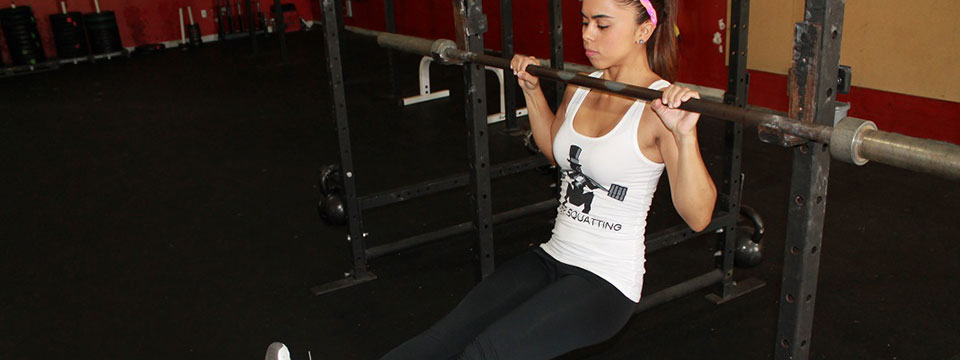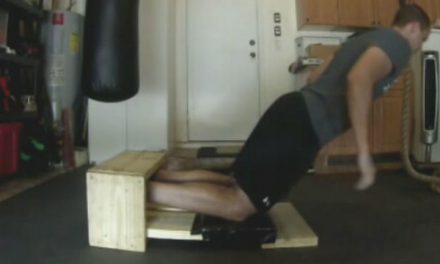by: Adam Sayih
Ah, the good ol’ strict pull-up. Nothing like having to elevate your entire body weight! Some people have no problem banging out strict pull-ups, however, a large population of CrossFitters see the word “pull-up” and are instantly defeated by what seems to be a mythical accomplishment.
Women in particular have a very difficult time conquering their first strict pull-up. Since the pull-up isn’t very technical, it’s mostly due to lack of strength, not skill, that holds women back. Over the years I’ve noticed why women fail to achieve their first pull-up and what it takes to get the chin over the barbell.
The Banded Pull-up Paradox
Most CrossFit boxes have no problem having athletes throw bands on the bar and allowing people to use this as an acceptable scaling for pull-ups. While this is ok for WODs, it doesn’t help much for developing pure pull-up strength. We all know that one person who has been using the same thick green band for the last two years. Heck, it might even be you. There’s several problems with using bands:
-
Bands take off nearly the entire load of the bottom portion of the pull-up (from extended arms to half-way up). The bottom half is the most difficult part of the pull-up, therefore using bands all the time will never strengthen this portion of the repetition.
-
Bands are elastic, therefore causing you to accelerate throughout the lift. First we had very little resistance from the bottom half of the rep and now we have momentum at the top half. The end result is a very low amount of force production done by the muscles, so very little “strengthening” is actually happening.
-
Bands often lead to weird banded kipping pull-ups. They aren’t exactly kipping pull-ups, but some sort of hybrid child of the kipping pull-up that works. While this may be acceptable in WOD standards, it isn’t doing much to help you achieve a strict pull-up.
-
Often a band is either too easy or too hard, so strengthening the pull-up requires strength work outside of the regularly scheduled WOD.
How to Conquer the Pull-up
The pull-up requires a dedicated strength plan. Waiting for the word pull-up to appear every once in awhile on the whiteboard isn’t going to cut it. You need a dedicated plan that will simulate actual pull-ups and strengthen the muscles in that specific movement pattern. In my experience with clients and athletes getting your first pull-up is as simple as periodizing four exercises and just requires hard work and patience.
Accountability is key. Most people know they have weaknesses but just don’t know how to address the issue. Here’s the exercises and your dedicated plan to get that glorious chin over the bar:
The Segment+Eccentric Pull-up
How to do it:
The name is a little crazy, but it’s the best way to describe what you’re doing. You’ll start on a box set up to a height where you can perform a pull-up. The great part about this set-up is that it can be adjusted to any strength level. If you’re very weak, you might have to stack some plates on the box so that you’re closer to the bar (you can even be just a few inches from the bar if needed). If you’re close to your first pull-up, you’ll be setting up a height that is a lot lower.
The reason it’s called a segmented pull-up is because this height will be referred to as a segment of the repetition. For example, if you are starting your pull-up on a height where your arms are bent 90 degrees, this a half-rep segment.
Now that you have the set-up, it’s time to do some work. Pull yourself over the bar from this position. The next step is lowering your body down is a slow and controlled manner to a complete dead hang. You’ll have to pull your feet back to avoid hitting the box. A common mistake I see when performed is people will lower themselves slowly to about half-way, hold it, then drop fast. You must lower yourself slowly throughout the entire range of motion to develop bottom half strength.
Why it works:
This is known as eccentric-enhanced training. What we’re really doing is overloading the eccentric phase of the pull-up, which is the going down portion. Since you’ve never performed a pull-up before, you’ve never experienced that much resistance loading on the back muscles. One study done by the Journal of Strength and Conditioning concluded that eccentric-enhanced training results in an increase in concentric power. The researchers believe that since a heavier than normal load is applied to the muscles, an increase in muscle tension and cross-bridging of fibers occurs [1]. Also, another benefit of eccentric enhanced training is that it strengthens tendons [2]. This is especially beneficial if you plan on performing kipping and other gymnastic exercises in the future.
The Barbell Assisted Pull-up
How to do it:
Set up a box a few feet away from a rack. Then set up a barbell on the rack. How high you set the barbell will be determined by your strength level. The weaker you are, the higher you will set the barbell so more weight is distributed to the box. Hold on to the barbell with a pull-up grip and put your feet on the box. While keeping a vertical torso, pull your chin over the bar as you would a pull-up. It’s very important to not use your hips to kip up. Always descend to fully extended arms and make sure the barbell is set to a height where your butt is not on the ground.
Why it works:
The barbell assisted pull-up is the most underrated exercise out there for those who can’t perform a pull-up. If someone can’t perform a push-up, we almost always recommend performing push-ups on the knees to remove some of the bodyweight. This exercise is essentially the same concept. You’re literally performing pull-ups with less bodyweight, however without any elastic momentum from a band. This allows you to produce force in the required muscles in a full range of motion which is necessary in the pull-up.
The Ring Row
How to do it:
Set up rings to a height that is roughly at the hip. Hold on to the rings and slowly lean back until the arms are fully extended and the torso and legs are straight. Pull on the rings until your hands reach your chest. Do not use your hip to assist you. The stronger you are, the lower your torso will be to the ground.
Why it works:
The ring row is a basic back strengthening exercise. If the other exercises are still too difficult even after adjusting to easier levels, stick with ring rows for awhile. The International Journal of Industrial Ergonomics did a study that revealed the most pulling strength is exerted when the arms are 90 degrees to the sagittal plane which means this a great exercise for beginners to start developing pulling strength [3].
The Dead Hang
How to do it:
Find a bar and literally just hang as long as you can!
Why it works:
You might be surprised but this exercise will really test your grip strength. If you can’t perform a pull-up there’s also a strong a chance that you can’t hang on a bar for more than 30 seconds as well. Having a weak grip is a contributor to pull-up weakness. The stronger your grip is, the greater your work capacity to perform pull-ups.
Putting it All Together: The Program
Perform before a WOD. I’ll be using Monday, Wednesday, and Friday as the examples, however you can use any days you choose, given there is at least one day in between to recover.
Monday
The Segment+Eccentric Pull-up
-5 sets of 4 repetitions. Take 3-5 seconds to descend to a dead hang. Rest 90-120 seconds between sets. We’re working on strength here, no need to rush.
The Barbell Assisted Pull-up
-3 sets of 6 repetitions. Rest 90-120 seconds between sets.
Wednesday
Ring Row
-4 sets of 8 repetitions. Rest 90 seconds between sets.
Dead Hang
-3 sets till failure. Just when you think you can’t hold on any longer, count to 15! Rest as needed.
Friday
The Segment+Eccentric Pull-up
-5 sets of 3 repetitions. Take 5 seconds to descend to a dead hang. Rest 90-120 seconds between sets.
The Barbell Assisted Pull-up
-3 sets of 5 repetitions. Rest 90-120 seconds between sets.
-1 set till absolute failure.
How to Progress
Progressing in the program is simple. Every week, you’ll make small progressions to continually challenge the muscles and get closer and closer to a pull-up. For the Segment+Eccentric Pull-up, you’ll lower the starting height. For example, if one week you started at a height on a box with three 10 pound plates, remove one plate. For the Barbell Assisted Pull-up, you’ll lower the barbell rack height. If you are already as low as possible without your butt touching the floor, start adding weight to your lap in the form of plates or kettle-bells. The dead hang, just hold on longer. For the ring rows, move your feet so your body angle is lower. Repeat this program as long as it takes to get a strict pull-up!
Cheers,
Adam
Stay connected!
Follow us on Instagram: @GentlemanAndMeathead
Like us on Facebook: https://www.facebook.com/GentlemanandMeathead
Follow us on Twitter: @classymeathead
References:
1. Sheppard, J., Young, K. Using Additional Eccentric Loads to Increase Concentric Performance in the Bench Throw. Journal of Strength and Conditioning Research. 2010.
2. Fahlstrom, Martin. Jonsson, Per. Chronic Achilles Tendon Pain Treated With Eccentric Calf-muscle training. Knee Surgery, Sports Traumatology, Arthroscopy. 2003.
3. Mital, Anin. Effects of Sitting and Standing, Reach Distance, and Arm Orientation on Isokinetic Pull Strengths in the Horizontal Plane. International Journal of Industrial Ergonomics. Volume 6, Issue 3. November 1990. 241-248








